
I am so gladyou asked that question! Let me explain (at length!)
Correlational research is really quite simple to do, and unfortunately, often intepreted incorrectly. A correlation is a measure of a LINEAR relationship between two variables. To obtain a correlation, all you need to do is measure two things you are interested in and then apply a simple statistical formula. In fact, these days, you can enter the scores on the two variables into just about any calculator with statistics functions (these cost all of about $30).
What does a correlation MEAN?

I am so gladyou asked that question! Let me explain (at length!)
If you have a positive correlation, it means that, as one variable increases,
another decreases. A correlation of +1.0 means that you can perfectly predict
one variable from another. For example, the graph below shows the correlation
between weight in kilograms (one kilogram = 2.2 pounds, this is the unit
usedin Europe for measuring weight - as if you care!) and weight
in pounds. As you can see, knowing someone's weight in kilos perfectly
predicts their weight in pounds. If you know one, you know the other
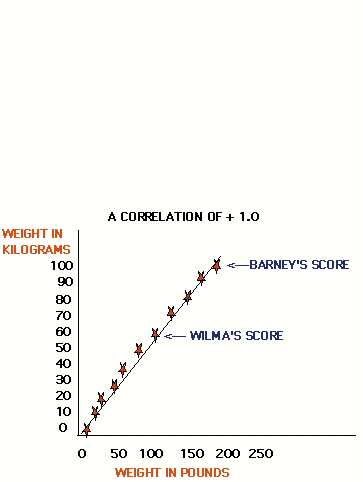
Each of the stars on the line represents an individual's score on both
variables. For example, Wilma weights 60 kilograms, which is about 132
pounds, Barney weights 100 kilograms, which is 220 pounds. The person who
weighs the most in kilograms, weighs the most in pounds also. Notice, however
THE WEIGHT IN POUNDS AND KILOGRAMS IS NOT THE SAME. A perfect correlation
doesn't mean that your score is the exact same on two variables, but your
rank order is the same. (This is a very simplified explanation of correlation,
and I suggest you take a statistics course at some point if you are intending
to major in psychology.) So, Barney doesn't weigh 100 pounds, in fact,
he weighs more than twice that, BUT he is still the heaviest person, Wilma
is still about in the middle. Let me repeat this: WITH A POSITIVE CORRELATION,
AS ONE VARIABLE INCREASES, THE OTHER INCREASES. A perfect correlation is
either +1.0 or -1.0. In either case, knowing a person's score on one variable,
you can perfectly predict the score on another.
A NEGATIVE correlation is shown below. A negative correlation means
that as one variable increases, another decreases. The example below shows
a correlation between the number missed on a test and the percentage correct.
Obviously, the more you missed (the higher the number missed) the lower
the percentage correct.
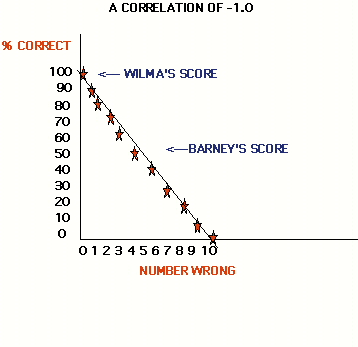 You can see that Wilma, who
had zero wrong, had 100% correct. Barney, who had 5 wrong, had 50% correct,
and so on. So, the HIGHER you scored on one variable (number wrong) the
LOWER you scored on another (percent correct). That is a negative correlation.
Now, you may have noticed that these are pretty trivial examples. I think
so, anyway. It's nice that your weight in pounds correlates perfectly with
your weight in kilograms, for example, but really, what good is it?
You can see that Wilma, who
had zero wrong, had 100% correct. Barney, who had 5 wrong, had 50% correct,
and so on. So, the HIGHER you scored on one variable (number wrong) the
LOWER you scored on another (percent correct). That is a negative correlation.
Now, you may have noticed that these are pretty trivial examples. I think
so, anyway. It's nice that your weight in pounds correlates perfectly with
your weight in kilograms, for example, but really, what good is it?
Please don't get the misimpression that correlation as a technique
is unimportant. It's just that very few things in real life can be predicted
PERFECTLY.
One of the higher correlations you will commonly see is shown below,
the correlation between IQ tests and achievement tests
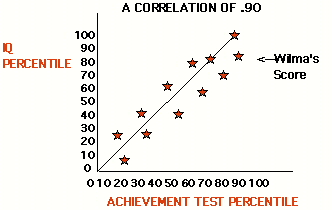
A percentile, by the way, is the percent of people in the population
who would be expected to get a score that high or lower. So, if you scored
in the 80th percentile, as Wilma did on the IQ test, 80% of the people
scored the same as you or lower. If you scored in the 25th percentile,
25% of the people scored the same as you or lower (and, 75% scored higher).
As you can see, IQ does not perfectly predict your score on achievement
tests. The scores are quite close, however, probably, in my opinion, they
represent very similar measures. That is, both IQ and achievement tests
measure how well you can solve problems and answer questions in a testing
situation with a time limit. As you would expect, there is a positive correlation.
People who perform better on intelligence tests perform better on achievement
tests. However, it is not a perfect correlation. Wilma, who tied with someone
else for highest on the achievement test, was NOT the highest ranked on
the IQ test. Knowing someone's IQ score gives you a pretty good idea how
they did on the achievement test, and vice versa.
Even correlations of .90 are pretty rare, a much more common correlation
would be around .50, which is shown below in the case of IQ and grade point
average. In fact, the correlation between intelligence test scores and
GPA is positive, but nowhere near 1.0 or .90.
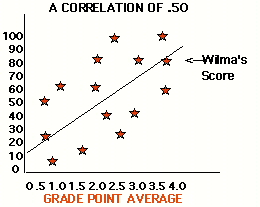
As you can see, Wilma has a grade point average of 4.0, so does another
student who scored at the 99th percentile on the IQ test (Wilma scored
at the 80th percentile). A third student with a 4.0 scored at the 60th
percentile. You would expect a positive correlation between intelligence
and grades, and, you can see, there is one, with the students with higher
ranks on the intelligence test tending to make better grades. Many other
factors also come in, though. Look at the two stars at the top of the chart.
Both of these students scored near the top end of the scale on the intelligence
test, as high or higher than 99% of the population, yet, one of these students
has a 4.0 GPA and the other has about a 2.0 GPA. There could be any number
of reasons why this difference exists. Maybe the student with the lower
grades is very intelligent but has a drinking problem and frequently misses
class. Maybe he is just lazy and has about the same motivation as your
average houseplant. Maybe he is working two jobs and just does not have
time to study. There are a great many possible reasons, and I am sure you
can think of many that I haven't mentioned. Most variables in human development
are like that, i.e., determined by a great many different factors. Not
surprisingly, you find a lot more correlations around the .50 level than
around the 1.0 level. And, sometimes, as in the example below, there is
no relationship at all. For example:
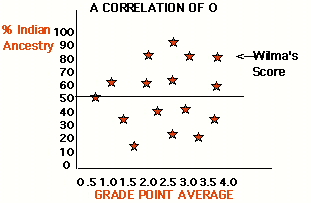
From my experience teaching at Cankdeska Cikana Community College,
there seems to be no correlation between percentage of Native American
ancestry and grades. This probably isn't the least bit surprising, because
you wouldn't expect to find any such relationship. As you can see from
the graph above, there are four people whose ancestry is about 60% Native
American, and their GPAs range from 1.0 to 4.0. So, while knowing someone's
intelligence test score gives you some indication of how well they will
do in school, knowing their percent of Native American ancestry tells you
nothing about how well they will perform at a tribal college.
MORE EXAMPLES:
Positive correlations (NOTE: The more you have
of one of these, the higher you tend to score on the other):
How many minutes a day someone reads to a child and his/her reading
achievement in elementary school.
The number of times a child is spanked in a week and the number of
times he/she hits other children at preschool.
The number of different words someone speaks to the child in the average
day and his/her vocabulary at age three.
Family income and years of education completed.
Severity of child abuse and number of psychological problems as an
adult.
Drinking during pregnancy and birth defects.
Negative correlations (NOTE: The more you have
of one of these, the LOWER you tend to score on the other):
How many hours a week a student works and his/her GPA.
Number of children a woman has and years of education completed.
Number of friends/family available for social support of a family and
number of incidents of child abuse in the home.
Prenatal visits and birth complications.
Zero correlations (NOTE: How high you score on
one of these, has NOTHING to do with how you score on the other):
How many times a week you vacuum and your child's intelligence.
Age at which child learns to walk and reading achievement in third
grade.
Number of grapefruits you ate during pregnancy and birth defects.
Before you go on and do anything else, complete this simple assignment
so I know that you understand the idea of a positive, negative and zero
correlation.
No fair using any of the examples I gave above! Please identify your
examples as positive, negative and zero as in the sample given below:
1. Positive: How frequently a child is praised and his/her self-esteem
2. Negative: How frequently a child is criticized and his/her self-esteem
3. Zero: The neatness of a child's handwriting and his/her self-esteem
Click here now to send your assignment.
Click here to return to the previous page.
Click here to go on to more information on correlations (whether you want to know it or not!)